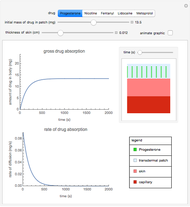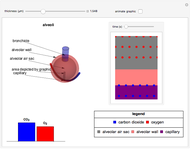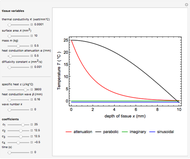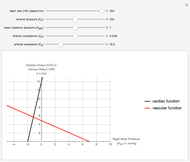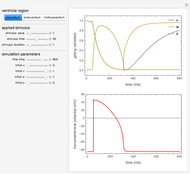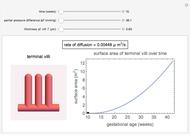Diffusion of Oxygen through the Placenta

Requires a Wolfram Notebook System
Interact on desktop, mobile and cloud with the free Wolfram Player or other Wolfram Language products.
Fick’s law of diffusion, given below, describes changes in concentration of solutes due to diffusion. This Demonstration explores the rate of diffusion throughout pregnancy between the fetus and mother at the terminal villi of the placenta. Use the sliders to control the three relevant variables. The rate of diffusion  depends on the constant diffusing capacity of oxygen
depends on the constant diffusing capacity of oxygen  , the surface area
, the surface area  (which changes with the time of gestation), the partial pressure difference
(which changes with the time of gestation), the partial pressure difference  of oxygen between the fetus and the mother and the thickness
of oxygen between the fetus and the mother and the thickness  of the villi (a genetic trait that can vary among individuals). Specifically,
of the villi (a genetic trait that can vary among individuals). Specifically,  .
.
Contributed by: Colleen Tacubao, Patrick Chen and Hazel Wong (April 2018)
Additional contributions by: Eitan Geva (University of Michigan)
Open content licensed under CC BY-NC-SA
Details
In the graphic for this Demonstration, the rate of diffusion is shown numerically at the top, the rate of diffusion is shown as a visual representation of terminal villi in the placenta and a plot shows the relationship between surface area and time. The rate of diffusion, calculated using Fick’s law, is determined by the partial pressure difference in oxygen between the mother and the fetus, the thickness of the villi, the diffusion capacity of oxygen and the surface area. The picture of the terminal villi shows the change in the rate of diffusion as the partial pressure difference, thickness or time, as set by the sliders. The shade of red of the box surrounding the villi is indicative of the partial pressure difference, with a darker shade of red indicating a greater partial pressure difference. Finally, the plot is able to show that, with increasing time, surface area of the placenta increases, which in turn increases the rate of diffusion of oxygen.
References
[1] W.-Y. Lim et al., “Maternal Blood Pressure During Pregnancy and Early Childhood Blood Pressures in the Offspring: The GUSTO Birth Cohort Study,” Medicine, 94(45), 2015 e1981. doi:10.1097/MD.0000000000001981.
[2] T. McNanley and J. Woods, "Placental Physiology." (Apr 10, 2018) www.glowm.com/section_view/item/195.
[3] Y. Wang and S. Zhao, "Cell Types of the Placenta," in Vascular Biology of the Placenta, San Rafael, CA: Morgan & Claypool Life Sciences, 2010. (Apr 10, 2018) www.ncbi.nlm.nih.gov/books/NBK53245.
Submission from the Compute-to-Learn course at the University of Michigan.
Snapshots
Permanent Citation







